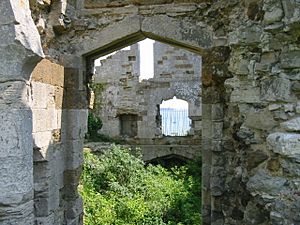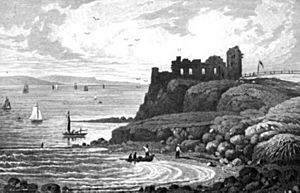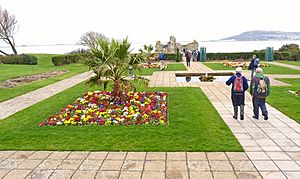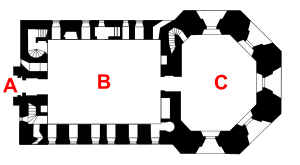Sandsfoot Castle facts for kids
Quick facts for kids Sandsfoot Castle |
|
|---|---|
| Weymouth, England | |

The castle overlooking the cliffs, 1998
|
|
| Coordinates | 50°35′43″N 2°27′39″W / 50.595222°N 2.460822°W |
| Type | Device Fort |
| Site information | |
| Owner | Weymouth and Portland Borough Council |
| Open to the public |
Yes |
| Condition | Ruined |
| Site history | |
| Materials | Portland stone |
| Events | English Civil War |
| Official name | Sandsfoot Castle |
| Designated | 15 May 1953 |
| Reference no. | 1020062 |
|
Listed Building – Grade II
|
|
| Official name | Sandsfoot Castle |
| Designated | 12 December 1953 |
| Reference no. | 1096763 |
Sandsfoot Castle, also known as Weymouth Castle, is an old fort built by King Henry VIII near Weymouth, England. It was part of the King's plan to build forts, called the Device programme, to protect England from attacks by France and the Holy Roman Empire. Sandsfoot Castle guarded the Weymouth Bay area where ships could anchor safely.
This stone castle had a round platform for cannons and a building called a blockhouse where soldiers lived. It was finished by 1542 and cost about £3,887. Later, in 1623, earth walls were added around the land side of the castle for more protection. Sandsfoot Castle was used during the English Civil War, changing hands between the King's supporters and Parliament's forces. It stayed in use for a while, but in 1665, after King Charles II returned to the throne, it was no longer needed by the military.
By the early 1700s, Sandsfoot Castle was falling apart. People even took its stones to build other things nearby. The clay cliffs it stood on were always crumbling into the sea. The castle's cannon platform eventually fell completely into the water by the 1950s. For safety, the ruins were closed to visitors, though gardens were created next to it in 1951. Between 2009 and 2012, the castle was repaired for £217,800, allowing it to reopen to the public. Historic England says Sandsfoot is "one of the most substantial examples" of these 16th-century forts still standing in England.
Contents
History of Sandsfoot Castle
Why was Sandsfoot Castle Built?
Sandsfoot Castle was built because of problems between England, France, and the Holy Roman Empire during the last years of King Henry VIII's rule. Before this, England usually let local lords and towns handle their own coastal defenses. The King didn't get very involved in building forts. While France and the Empire were fighting each other, a real invasion of England seemed unlikely. There were some small forts in the south-west and along the Sussex coast, but most defenses were very basic.
After 1533, King Henry VIII decided to end his marriage to Catherine of Aragon. This made the Pope and Catherine's nephew, Charles V, very angry. In 1538, France and the Holy Roman Empire teamed up against Henry, and the Pope encouraged them to attack England. It looked like England would be invaded. To prepare, Henry issued a special order in 1539, called a "device", telling people to build forts along the English coast to defend the country.
Sandsfoot Castle was built to protect the Weymouth Bay anchorage, a safe place for ships to stop. It was placed on cliffs across the water from Portland Castle. Sandsfoot was a blockhouse, meaning it was designed to fire heavy cannons at enemy ships. It didn't have much protection from attacks by land. The castle was finished by 1541. A captain, chosen by the King, ran it. It cost about £3,887 to build. The nearby village of Wyke Regis probably agreed to help the castle. In return, they didn't have to pay certain taxes or serve in the local army. A writer named John Leland visited the castle soon after it was built. He called it "a right goodlie and warlyke castle" with "one open barbican," which was likely the cannon platform.
The cliffs the castle stood on were always eroding, or wearing away, which quickly threatened the castle. By 1583, a "great gulf" had formed on the sea side, and repairs costing £383 were needed. These were done by John Wadham, who was a Member of Parliament and the captain of Sandsfoot Castle. In 1588, when the Spanish Armada threatened England, 50 extra soldiers were sent to Sandsfoot to help defend it.
Sandsfoot Castle in the 1600s and 1700s
Between 1610 and 1611, the castle's captain, Sir George Bampfield, spent £211 on repairs. In 1623, a survey showed the castle had ten iron cannons and a small group of soldiers: its captain, five gunners, and three regular soldiers. The castle was in poor shape, and the sea had damaged one part of the cannon platform. Fixing it would cost about £459.
During the English Civil War, which was a fight between King Charles I's supporters and Parliament's supporters, Weymouth mostly supported Parliament. The forts around Weymouth were held by Parliament's forces. In 1643, Robert Dormer, the Earl of Carnarvon, came to Dorset with an army. Weymouth surrendered, and Sandsfoot Castle was controlled by the King's supporters from August 1643 to June 1644. During this time, the castle might have been used to make coins for the King. Then, Robert Devereux, the Earl of Essex, took the area back for Parliament. The King's governor of Weymouth, Colonel William Ashburnham, went to Portland Castle without a fight. Devereux approached Sandsfoot, and after three hours of talks, the fort surrendered to him. In 1647, Parliament ordered the soldiers at the castle to leave, but this didn't happen, and John Hayne became the new captain.
When Charles II became King again in 1660, a new order was given to remove the soldiers from Sandsfoot. Then, an argument started between Humphrey Weld, who was in charge of Portland and captain of Sandsfoot Castle, and Charles Stewart, the Duke of Richmond. They argued over who controlled the local defenses. The people of Wyke Regis asked Weld to stop the soldiers from leaving. They were worried they would lose their special tax breaks if the Duke took over. Weld supported them, but he was removed from his job. The Duke then took over Sandsfoot with his own soldiers. Weld complained to the government. In 1665, a decision was made: Weld would get his job back, and Sandsfoot would be taken out of military use and torn down. The castle was never fully destroyed and was used as a storage building until at least 1691.
By 1725, the castle was in ruins. Early in the 1700s, the castle's remains were sold to the town of Weymouth. People used some of its stones to build their new town bridge. In the 1800s, people in Weymouth believed that several houses in the town were also built with stones from the castle. In 1825, a carved stone coat of arms from the castle was moved to All Saints Church in Wyke Regis. Even though the castle was a ruin, captains were still officially appointed. Gabriel Stewart held the position as late as 1795.
Most of the cannon platform fell into the sea as the cliffs crumbled away. No one is sure exactly when this happened. Historians have debated it, with some saying it was in the 1700s, others in 1835, and some in the late 1800s. Many artists drew and painted the ruined castle in the 1700s and 1800s, including Samuel Buck and Edward Pritchard. The castle was also featured in Joseph Drew's short story "the Poisoned Cup" in 1876.
Sandsfoot Castle in the 1900s and 2000s
In 1902, the Weymouth Corporation bought the castle from the government for £150. During the Second World War, the castle had an anti-aircraft gun battery. This was part of the defenses around Portland Harbour. Even with the new breakwaters built nearby, the unstable clay cliffs kept eroding. In 1930, the ruins were closed to the public because they were unsafe. The last part of the cannon platform fell in the 1950s.
In 2009, the Heritage Lottery Fund gave £23,100 for a first look at the site. By this time, English Heritage had listed the castle as a building at risk of falling apart. Then, in 2011, another £194,700 was given for major repair work. As part of the repairs, a three-dimensional laser scan was made of the stonework. A new walkway made of steel and oak was put inside the castle. The castle reopened to the public in 2012. The next year, it was removed from English Heritage's "at risk" list. Sandsfoot Castle is protected by UK law as a Grade II* listed building and a scheduled ancient monument.
What Sandsfoot Castle Looked Like
Sandsfoot Castle was built using Portland stone. It had smooth stone on the outside and rough stone inside. It had a main building, called a blockhouse, connected to an eight-sided room for cannons, which faced the sea. The blockhouse was about 42 feet by 32 feet and had a gate-tower on the side facing land. It probably had four rooms for soldiers to live and cook, with stairs going up to the second floor and down to the basement. The gate-tower had a small room on its top floor and was designed to hold a portcullis, a heavy gate that could be lowered. The cannon room was one story high, about 36 feet by 28 feet. It had five openings for cannons and a flat roof that likely also held cannons. Both the cannon room and the main building probably had protective walls called parapets.
The cannon room has been lost to erosion, but you can still see one of its cannon openings where it fell onto the beach below. Most of the smooth stone on the outside of the blockhouse has been taken, but some parts remain. The roof and floors are also gone. Historic England believes the castle is "one of the most substantial examples" of an original 16th-century blockhouse in England.
The castle originally had an outer area, reached by a bridge, and stables, but these are now gone. Rectangular earth walls were built to protect the castle from the land side, probably in 1623. These had two strong points, called bastions, in the north and west corners. There was also some kind of stone structure along these earthworks. In the 1700s, these earthworks were described as a "deep trench." In the mid-1800s, they were said to be about 12 feet deep. Today, only about 100 feet of the bank and ditch remain. The earthworks are about 10 meters wide and 2.2 meters deep from the top of the bank to the bottom of the ditch. The north bastion is still mostly there, but the west one has been mostly destroyed. Outside the entrance to the earthworks are the Sandsfoot Gardens. These public gardens were created in 1951 and are designed in a Tudor style with a decorative pond.
Images for kids
See also
 In Spanish: Castillo Sandsfoot para niños
In Spanish: Castillo Sandsfoot para niños













